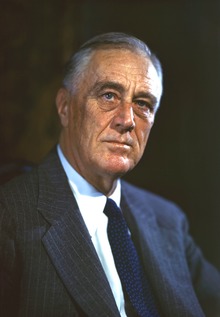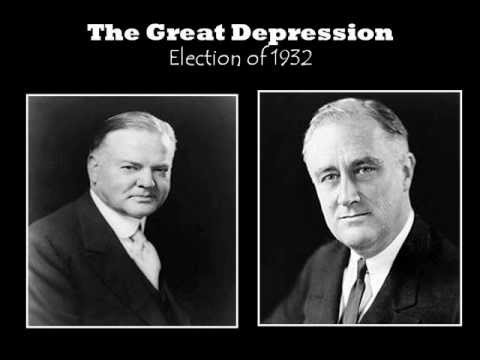LISTEN TO TLR’S LATEST PODCAST:
By Ian Tartt

This is the second of a three-part series examining the gradual death of the American Dream. The first entry examined how the groundwork was laid, and this entry will focus on the next stage that built upon that initial foundation. So, without further ado…
Return to Normalcy, the Roaring Twenties, and the Great Depression
After World War I ended and as Woodrow Wilson’s presidency was winding down, Republican candidate Warren G. Harding ran for president with the idea of a “return to normalcy”. Harding wanted to return to a pre-war mindset, ease the concerns many people were feeling, and focus more on national affairs than international affairs. This worked in his favor, as Harding won the 1920 election by a landslide.
Harding’s presidency saw many problems and controversies. For one thing, the inflation of the money supply used to help finance US involvement in WWI resulted in a major depression in the early 1920’s. In keeping with the example followed by prior presidents, Harding did not intervene in an attempt to lessen the severity or length of the depression. As a result, the depression was over in about a year and a half.
Another major incident, and one of the most infamous events from Harding’s time in office, was the Teapot Dome Scandal. In short, this involved Secretary of the Interior Albert Fall secretly granting exclusive rights to federal oil deposits to a handful of companies. The extent of illicit activity wasn’t fully discovered during Harding’s presidency. Despite these and other setbacks, Harding managed to reduce the national debt by $2 billion, and his successor Calvin Coolidge further reduced it by $5 billion.
About halfway through his term, Harding died, perhaps as a result of stress from the Teapot Dome Scandal. Vice President Coolidge was then sworn in as the 30th president of the United States. Coolidge accomplished great things in his six years as president. Some of his accomplishments include reducing the national debt, massively cutting taxes, and keeping federal budgets low. This helped contribute to the economic prosperity during his presidency that is often referred to as the “Roaring Twenties”.
However, his presidency occurred during a time of monetary inflation. If the money supply had remained constant, then the increased efficiency of production would have resulted in prices that gradually fell. Instead, the inflation roughly canceled out the decline in prices, meaning that prices remained stable during most of the 1920’s and therefore consumers didn’t benefit from reduced prices they could have had in absence of the inflationary boom.
By 1929, the inflationary boom had come to an end, and the Great Depression began. It’s commonly thought that the depression was so severe and lasted so long because President Herbert Hoover refused to intervene. However, Hoover did in fact intervene, and in doing so broke with every prior president who oversaw an economic depression. Some of those interventions included raising taxes and increasing government spending, which showed that Hoover was not the free market enthusiast his modern critics make him out to have been.
Hoover’s interventions were essentially a sneak preview of the New Deal that would be introduced by his successor, Franklin Roosevelt. As a result of his interventions, the depression, which was actually less severe initially than the one in the early 1920’s that Harding didn’t touch, dragged throughout the remainder of Hoover’s presidency.
Franklin Roosevelt and the New Deal
In the election of 1932, Roosevelt campaigned against Hoover’s high spending and increased government control of the economy. In the process, he decried Hoover for overseeing “the greatest spending administration in peacetime in all of history” and said the following quote at that year’s Democratic National Convention that made him sound like a fiscal conservative:
“For three long years I have been going up and down this country preaching that Government–Federal and State and local–costs too much. I shall not stop that preaching. As an immediate program of action we must abolish useless offices. We must eliminate unnecessary functions of Government–functions, in fact, that are not definitely essential to the continuance of Government. We must merge, we must consolidate subdivisions of Government, and, like the private citizen, give up luxuries which we can no longer afford.”
After he was elected, however, Roosevelt abandoned that sort of rhetoric and proceeded to spend and intervene more over the course of his presidency than Hoover and all prior twentieth century presidents. Just as Hoover prolonged the Great Depression until the end of his presidency, Roosevelt prolonged it until the late 1930’s/early 1940’s with his many interventions.
One of these interventions came in the form of the Agricultural Adjustment Act, which reduced the supply of food, raised food prices, and got farmers addicted to government handouts. It did this by paying farmers to produce and sell less food than they normally did. Roosevelt figured that raising prices of farm products would help farmers who had been hit hard by the depression, and by reducing the supply of farm products while demand for them remained high, the prices would rise. Roosevelt was right. The fact that so many people had very little money during this time and now had to pay even more for food that had been made artificially scarce meant that this legislation hurt poor people as much as it helped farmers.
Perhaps the most famous piece of legislation Roosevelt signed was the Social Security Act of 1935. Sold as a program to support people in their retirement, this was really part of Roosevelt’s grand plan to get more people dependent on government programs so that he would get reelected. Over time, however, this has been a means by which politicians can fund anything they like, whether or not it’s related to Social Security. Social Security has stuck around so long for these three reasons: it gives politicians a lot of money to play with, retired people think they’re getting back the money they paid into the system when they were younger, and working people hope to someday get back the money that’s currently being taken from them. So as long as politicians can keep using that money to fund their own pet projects, and without a comprehensive plan that would both support retired people and exempt working people from the Social Security tax, Social Security will continue well into the foreseeable future.
Early in his presidency, Roosevelt signed an executive order that required Americans to surrender monetary gold to the government. At the time, the US was still on a gold standard, which meant that paper dollars could still be redeemed for their value in gold. This put a strong limit on how much the Federal Reserve could inflate the money supply. By making it illegal to own monetary gold, Roosevelt essentially took the US off the gold standard and removed the limit on inflation. While gold retains its value over time, meaning that an ounce of gold can buy about as much now as it could a century ago, this inflation calculator demonstrates how much value the dollar has lost over time. Roosevelt may not have brought about the devaluing of the dollar, but he certainly accelerated it.
Public works projects were a major focus of Roosevelt’s presidency. Some of the ways he went about this included establishing the Civilian Conservation Corp, the National Industrial Recovery Act, the Public Works Administration, and the Works Progress Administration. Many are aware that roads, bridges, schools, and parks were either built or maintained in accordance with the relief efforts. However, how many know that tax dollars were also spent paying people to study the history of the safety pin, scare birds with balloons, and chase tumbleweeds? With the power to tax at his disposal, Roosevelt could pay people to do practically anything. The usefulness of these public works projects took a backseat to the appearance that they were contributing to the recovery effort and making him look good in the process.
Fortunately, Roosevelt faced opposition for at least some of his ideas. The Supreme Court declared several of his ventures to be unconstitutional. In response, Roosevelt developed a plan to try to get the court on his side. He wanted to pack the Supreme Court by appointing one new judge for every judge on the bench that was over 70 years old. This could have allowed him to appoint a total of 6 judges who would be sympathetic to his goals. His plan failed, but it sent a clear message that Roosevelt would try anything if he thought it would give him more power.
World War II
On December 7, 1941, the US naval base Pearl Harbor was attacked by the Japanese military. This prompted the US, which had hitherto stayed out of the global conflicts occurring at the time, to officially enter World War II. Some historians believe that Roosevelt wanted the US to enter World War II, and as a result he goaded the Japanese into attacking Pearl Harbor so the US would reason to do so. Whether or not he intentionally brought on the attack, he certainly took advantage of opportunities created as a result of US entry to further expand his power. Some of what came about were the National War Labor Board, the War Manpower Commission, the Office of Economic Stabilization, the War Production Board, the Office of War Information, and the National Housing Agency. These new creations allowed Roosevelt even more control over real estate, prices, supply of goods, conscription, labor, and industries.
In February of 1942, Roosevelt ordered the interment of over 100,000 Japanese Americans, the majority of whom had been born in the US. There was no evidence of wrongdoing on the part of those interned, and some had fought for the US in World War I, which makes this one of the most heinous actions ever committed by a US president. Because propaganda films made the camps appear to be almost like vacation spots, as well as the Supreme Court defending Roosevelt’s actions, it wouldn’t be until 1988 that any real attempt at reparations would be made for those who had been interned.
Roosevelt’s Lasting Damage
Toward the end of his presidency, Roosevelt unveiled what he called a “Second Bill of Rights.” Unlike the Bill of Rights, which were all about negative rights (that is, the right to be free from force), Roosevelt wanting to implement reforms to create positive rights (effectively guaranteeing certain services to people even if force had to be used to do so). Due to his death about a year later, Roosevelt never got to see his Second Bill of Rights come to fruition. However, the actions he took as president laid the groundwork for much of what he desired to come to pass in the decades to come.
To accomplish much of what he did over his unprecedented 4 terms in office, Roosevelt made extensive use of executive orders. By the time he died in 1945, he had issued a total of 3,721 executive orders, more than any other president in history. By greatly expanding government and subsequently making millions of people dependent on government programs (whether it was for relief or for employment), Roosevelt succeeded in making the Federal Reserve and the income tax, both of which were necessary to fund the new programs, permanent parts of the US government. Those who depend on government to put food on the table aren’t going to vote for smaller government, so by creating the modern welfare state and helping create the military-industrial complex, he essentially guaranteed that those desiring smaller government would be outvoted by those who depend on government programs.
This has been a brief look at some of the changes made in the US government over approximately the middle part of the twentieth century that essentially guaranteed that the American Dream would someday kick the bucket. More information related to these subjects can be found in the excellent books “9 Presidents Who Screwed Up America: And Four Who Tried to Save Her” and “The Forgotten Man: A New History of the Great Depression”. The final entry in this series will examine the postwar period through to the late 1960’s and how the nails were further hammered into the American Dream’s coffin during that time period. See you next week for the conclusion to this series.




